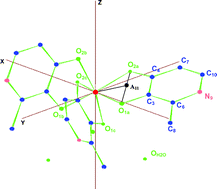New lipophilic 3-hydroxy-4-pyridinonate iron(iii) complexes: synthesis and EXAFS structural characterisation†
Abstract
New tris-iron(III) chelates of 3-hydroxy-4-pyridinone ligands derived from maltol (3-hydroxy-2-methyl-4-pyrone) or ethylmaltol (2-ethyl-3-hydroxy-4-pyrone), including a variety of N-aryl (phenyl, 4′-tolyl, 4′-(n-butyl)phenyl, 4′-(n-hexyl)phenyl) and N-benzyl (4′-methylbenzyl, 4′-fluorobenzyl and 4′-(trifluoromethyl)benzylamine) substituents on the nitrogen atom of the pyridinone ring, have been prepared. Characterization by C,H,N elemental analysis and thermogravimetric measurements indicates that most of the complexes are obtained as hydrates of general formula ML3·xH2O. Structural characterization of these difficult to crystallize lipophilic complexes has been achieved by EXAFS spectroscopy. Solutions of iron(III) complexes of maltol, ethylmaltol, 1,2-dimethyl-3-hydroxy-4-pyridinone and 1-phenyl-2-methyl-3-hydroxy-4-pyridinone in methanol–water mixtures were also examined by EXAFS. Distances from the central atom to ligand atoms, within 6 Å of the metal, have been determined in the solid and solution samples and the results show that the structure observed in the powder is maintained in solution. The local structure around the metal centre, bond distances and bond angles, does not change significantly with variable lipophilicity, thus indicating that ligands may be tailored according to specific needs without altering their chelation properties. EXAFS data analysis for this set of tris-iron(III) compounds illustrates the important contribution of both intra-ligand and inter-ligand multiple scattering pathways through the metal centre to a peak observed in the FT spectrum at twice the metal ligand distance (∼4 Å). The present results demonstrate that EXAFS features at twice the metal–ligand distance are valuable in the assignment of molecular geometry and that location of hydration water molecules, by EXAFS analysis, is limited by the geometry of the complexes, in particular for those in which ligands containing phenyl rings are present.


 Please wait while we load your content...
Please wait while we load your content...